|
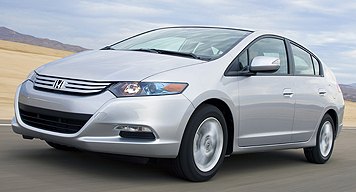
|
Second generation Insight strikes back
Toyota's dominance...
|
10 years into the market
of
hybrid power cars, Honda has yet to make a significant impact. When it
introduced the first Insight in 1999, we described it as an experiment
and an insight into the future. The small 2-seater coupe was capable of
70 mpg on highway while delivering decent performance. AutoZine thought
it was a better solution than the contemporary, first generation Toyota
Prius, which was slower, thirstier and costlier. However, sales of the
Insight never got beyond the crowd of active environmentalists. When
the first wave of demand dried up, it cruised to a halt and let the
second generation Prius to have a really big time. As of the end of
last year, Toyota had sold more than 1 million Prius worldwide,
while the whole hybrid fleet of Honda, consisting of Insight, Civic
Hybrid and Accord Hybrid, managed just a quarter of that number. Its
hybrid attempt has yet
to turn a profit.
Envying the success of Toyota, Honda has developed the second
generation Insight. This time it is converted to a 5-door hatchback
like Prius. With its new found practicality and an unbelievably low
price tag - around US$20,000 in the USA or £15,500 in the UK, or
20% cheaper than Prius – Honda set an ambitious sales target of 200,000
units per year, half of which will go to the North America.
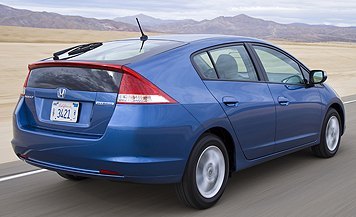
|
200,000 units of sales target is made
possible by an affordable price...
|
Frankly, I found the latest version of IMA (Integrated Motor Assist)
does not present any real technological breakthrough. Its construction
remains the same as before, consisting of a fuel-efficient 1.3-liter
four-pot engine, a CVT and a thin brushless DC motor sandwiched between
them. The battery is still conventional Nickel-Metal Hydride type,
whose power density and charging time are inferior to the Lithium-ion
batteries to be employed by Chevrolet Volt. However, what Honda
emphasizes this time is affordability. While Volt is destined to be
produced at a loss, Honda wants its new hybrid passenger car to earn
real profit for the company. Therefore cost reduction was the no. 1 job
in its development.
To reduce cost, Honda built the new Insight with many parts from Fit /
Jazz, such as the low-cost strut and torsion-beam suspensions. Besides,
the Insight is designed to be a compact car, unlike the mid-size Prius,
with a 2550mm wheelbase, 4395mm length, 1695mm width and 1425mm height.
This keeps its weight at a relatively manageable 1240kg. Lower weight
means the motor and battery pack can be made smaller to save costs. The
motor produces 13.6hp and 58 lbft of torque instead of 20hp / 76 lbft
that used in Civic Hybrid. The battery now consists of 84 instead of
132 D-size battery cells.
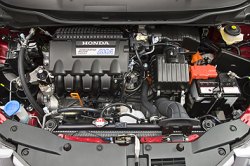
|
No breakthrough in the new IMA power
system....
|
The 1339cc engine is a simplified version of the one employed by Civic
Hybrid. It continues to use 2 valves and twin-spark plugs per cylinder
to favour fuel economy instead of power. Its i-VTEC system has 2 sets
of cam lobes, one for normal operation and another with zero lift to
shut down the cylinders during electric mode to reduce pumping loss.
This contrast to the 3-stage i-VTEC in Civic Hybrid which includes
low-rev, high-rev and cylinder deactivate cam lobes. The engine here
produces 88hp and 91 lbft of torque. The combined output of engine and
motor is 100hp at 5800rpm and 123lbft at 1000-1500rpm, enough to pull
the Insight from rest to 60 mph in 11 seconds. Top speed is also
reasonable at 113 mph.
Unlike Prius, the small motor of Insight cannot start the car from
rest. The engine is still the main propulsion unit while the motor
provides additional assistance. Once the car is rolling - at light load
and below 30mph -the engine may shut down, leaving the motor to work
alone to save fuel. During braking the motor recharges the battery. Low
rolling resistance 175/65SR15 tires are adopted to reduce energy
consumption. Honda claims its combined fuel consumption at 41 mpg US
EPA and 64.2 mpg EU. CO2 emission is
101g/km. That’s a lot better than conventional cars, but not good
enough to match the third generation Prius, which achieves 50 mpg EPA,
72.4 mpg EU and 89g CO2 per kilometer.
Some European eco diesel hatchbacks can also easily better those
figures.
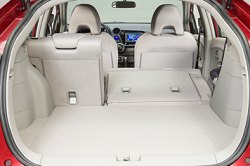 |
Compensating the tight rear passenger
room is a large boot...
|
On the road, the Insight drives like a conventional car, displaying
decent
body control and agility, although its skinny tires do not produce a
lot of grip. The ride is unexpectedly firm, translating to tight roll
control but failing to iron out some road irregularities. The steering
and braking feel surprisingly natural, without the artificial /
discrete weighting of other hybrid cars. It is definitely more fun to
drive than Prius. However, refinement is not its strongest suit. Apart
from the ride quality issue, its cabin is troubled by excessive engine
noise. Under acceleration, the small engine is prone to scream as the
CVT keeps it running at high rev. It also sounds breathless in
high-speed cruising. Prius is much more refined.
Outside, the Insight looks remarkably similar to Prius Mk2, sharing the
same sleek monospace profile. Some may accuse it for copying the Toyota
or lacking originality. From engineering point of view, however, this
is a shape optimized for aerodynamic drag, so their similarities are
not without reasons. That said, Honda did not make the best of this
shape, as its drag coefficient is 0.28, more than the 0.25-0.26 we have
expected.
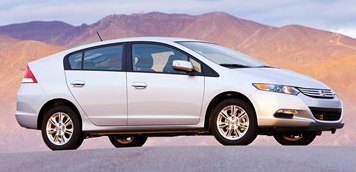
|
Exterior design copied Prius, or just
shaped by the same physics ?
|
The interior of Insight looks quite conventional except the color LCD
dashboard which displays the running state of IMA system. The front
seats, steering wheel and instrument readings are mounted like
conventional cars, so it is immediately intuitive. You won't be pleased
with its all-round hard plastics and other signs of cost cut, but at
least the ergonomics are good and the seats are comfy. As you can
predict from its compact dimensions and curvy roof profile, the front
seats are spacious but the rear seats are short of head and knee room
for 6-footers. A full family will be better catered by Prius or Civic
Hybrid. Nevertheless, the Insight offers a very usable luggage space
measuring 408 liters. The rear seatback can fold flat to expand the
luggage area further. As the battery pack is located under the luggage
floor while fuel tank is placed under the back seat, they do not
intrude into the luggage compartment.
As statistics found out, driving habits are probably more crucial to
fuel saving than technology. Therefore, like most other hybrids, the
LCD speedometer of Insight incorporates some fancy features to
encourage you to drive economically. If you are light on gas pedal and
keep the engine at the middle of power band, the speedometer will
change from blue to green. To enhance fuel economy further, press a
green button marked with “Econ” and it will switch to economy
strategies for throttle and transmission, and tune down the air
conditioning. The car will become sluggish, of course, but to keep the
car running in green zone is a fun challenge, just as engaging as
powersliding your performance car.
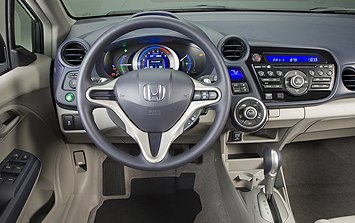
|
To keep the car running in green zone
is a fun challenge, just as engaging as powersliding your performance
car...
|
Overall, the new Insight is a decent car to drive and to own. It has
relatively little to give up in driving manner or practicality in the
process of pursuing greenness. While it has not broken any new ground
in hybrid technology, it succeeds to bring hybrid technology to a new
level of affordability. The majority buyers of Golf or Corolla may
consider a hybrid for the first time ever. This could be the most
significant Honda for years. |